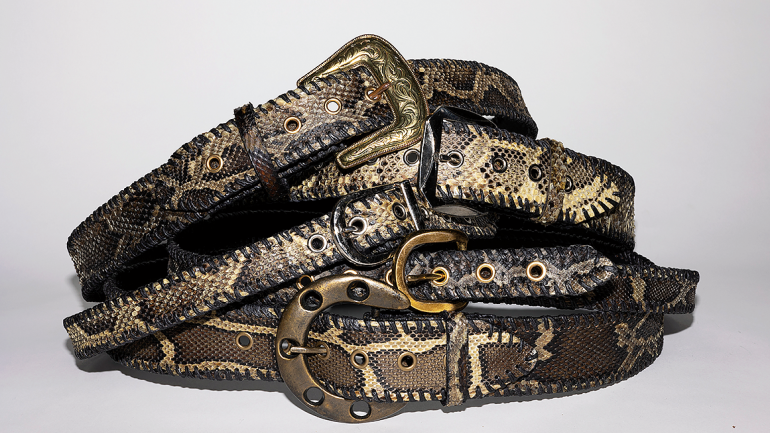Second Skins
Second Skins
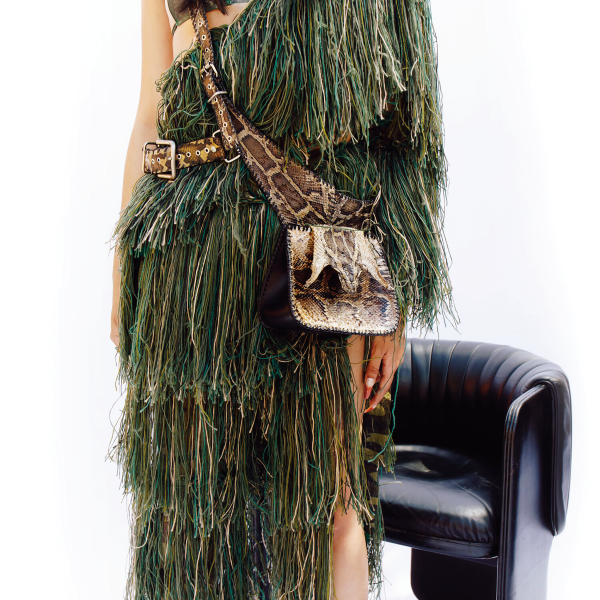
Model wears a deconstructed Ghillie suit and python cross-body skeleton vest with detachable ammo pouch and snake head detail.
The first time Elle Barbeito skinned a Burmese python, she made each move carefully. “Layer by layer, I could see all the connections within it. It was fascinating, and a little gross, but also really beautiful at the same time.”
Today, Barbeito gives these skins a second life through fashion and functional art. The Miami-based designer creates edgy collections of clothes, bags, sheaths, and even furniture from the preserved skins of pythons. The work was sparked because of two significant environmental issues: the proliferation of this invasive species in Florida and excess textiles.
After pursuing a degree in fashion design at the Pratt Institute in New York City, Barbeito felt disillusioned by the waste the industry generates. According to the UN Environment Programme, the equivalent of a garbage truckload of textiles is buried in a landfill or burned every second. “It was getting really exhausting to see how much waste was being produced, to be part of an industry that causes so much damage,” she says.
Unsure of her next steps after graduation and considering a move home to the Miami area, Barbeito had an unusual conversation with her father, Mark Yon, that changed her creative trajectory. “I remember I had called him one day, and he didn’t answer. He returned my call the next day and said, ‘Sorry I missed you. I was in the Everglades last night hunting snakes.’”
The ecological balance within the wetlands of the Everglades is being upended by a creature from the other side of the world. Through a combination of irresponsible exotic pet ownership and the destruction of a python breeding facility during 1992’s Hurricane Andrew that drove countless snakes into the wild, the Burmese python population has been steadily growing in the swamp’s dark waters.
With lengths reaching 20 feet and the largest snakes growing as wide around as telephone poles, the python has no natural predator in the South Florida swamps; it has decimated the mammal population in its coils, nearly eradicating rabbits, foxes, raccoons, and opossums from the ecosystem. The South Florida Water Management District began the Python Elimination Program in 2017 to mitigate the damage, paying trained agents to cull the snake population.
Few people eat Florida’s pythons, due in part to their high mercury levels, so most agents discard the bodies after logging their capture. Barbeito’s father sought a better way to honor the pythons’ lives by teaching himself to clean and preserve their skins. “He has always been a Gladesman,” she explains. “He loves snakes and hates having to kill them, but he also realizes the impact they’re having. It felt crazy to him that people were just throwing them away.”
Her father’s efforts opened a door for Barbeito to pursue design in a way that aligned with her convictions around waste while viscerally connecting her to her sense of place: “I started experimenting and decided to do a collection inspired by my move back to Florida and getting back in touch with my roots.”
Though snakeskin visually conveys an air of fierceness, it is a delicate material. After skinning a snake, Barbeito cleans the skin, then cures it in a mixture of glycerin and alcohol for two weeks, which makes its texture rubbery. The skin must then be stretched and nailed down to dry, a process that can take anywhere from a week to a month. “It’s fully a matter of working with the weather at that point,” Barbeito says.
To enhance its structure and durability, she binds the skin to vegetable-tanned leather from cattle. Barbeito quickly discovered that traditional leatherworking tools tear snakeskin, so she developed her own technique: “Every single stitch is measured and drilled one by one. It’s a very tedious process.”
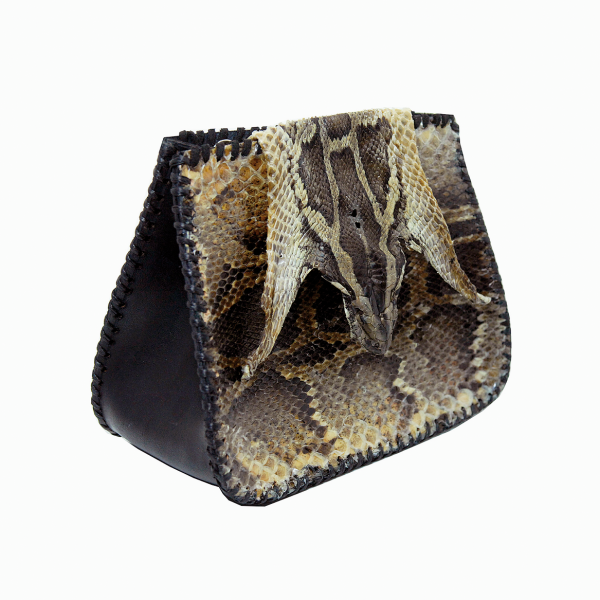
Burmese python ammo pouch with snake head detail, vegetable-tanned leather, python skin, waxed cotton thread.
To enhance its structure and durability, she binds the skin to vegetable-tanned leather from cattle. Barbeito quickly discovered that traditional leatherworking tools tear snakeskin, so she developed her own technique: “Every single stitch is measured and drilled one by one. It’s a very tedious process.”
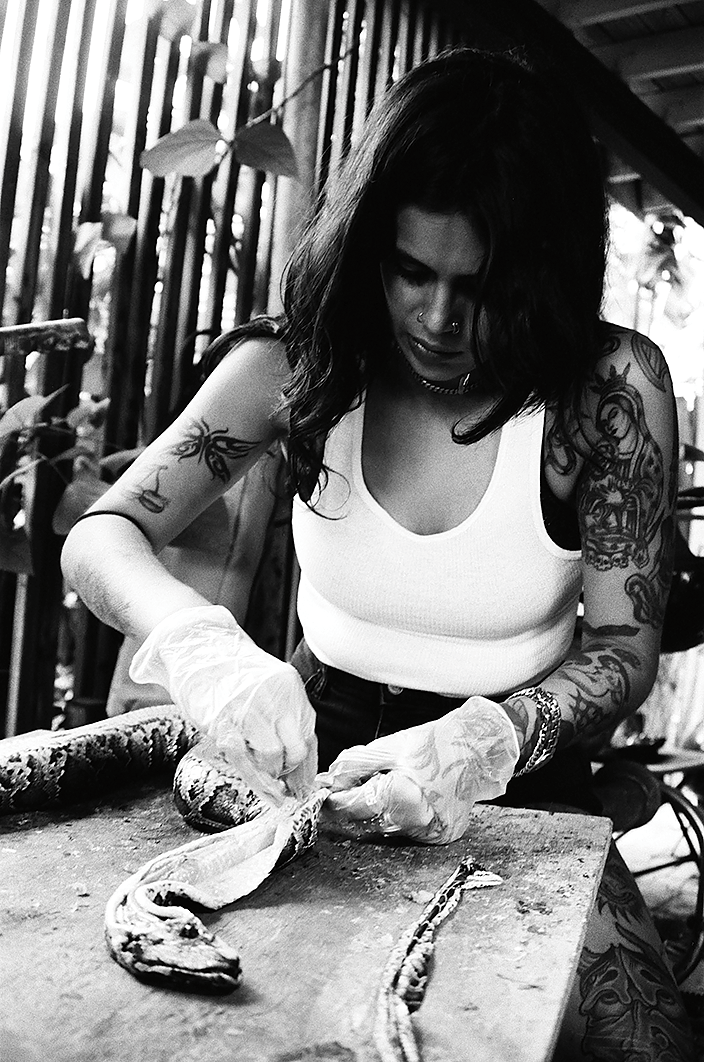
Barbeito removing the skin from a python using only a razor blade.
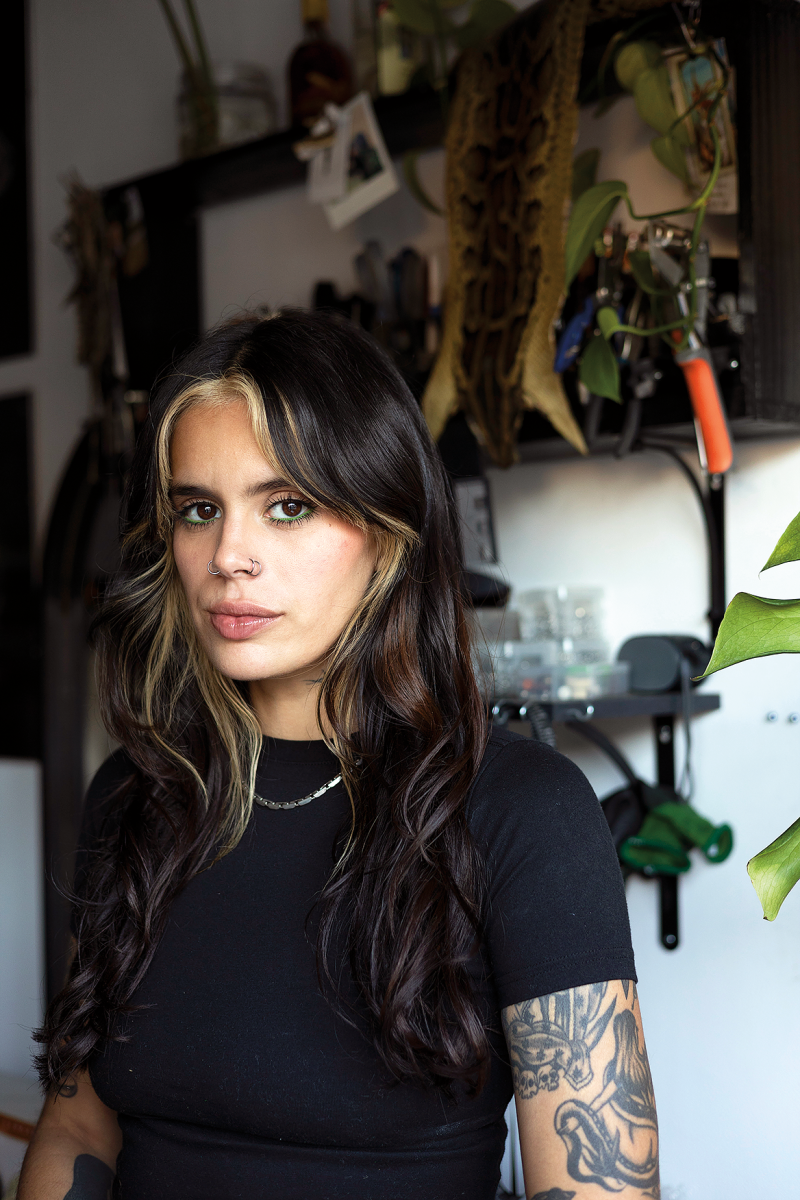
Portrait of artist and designer Barbeito, a Miami native who blends “intention, sustainability, and function within her practice.”
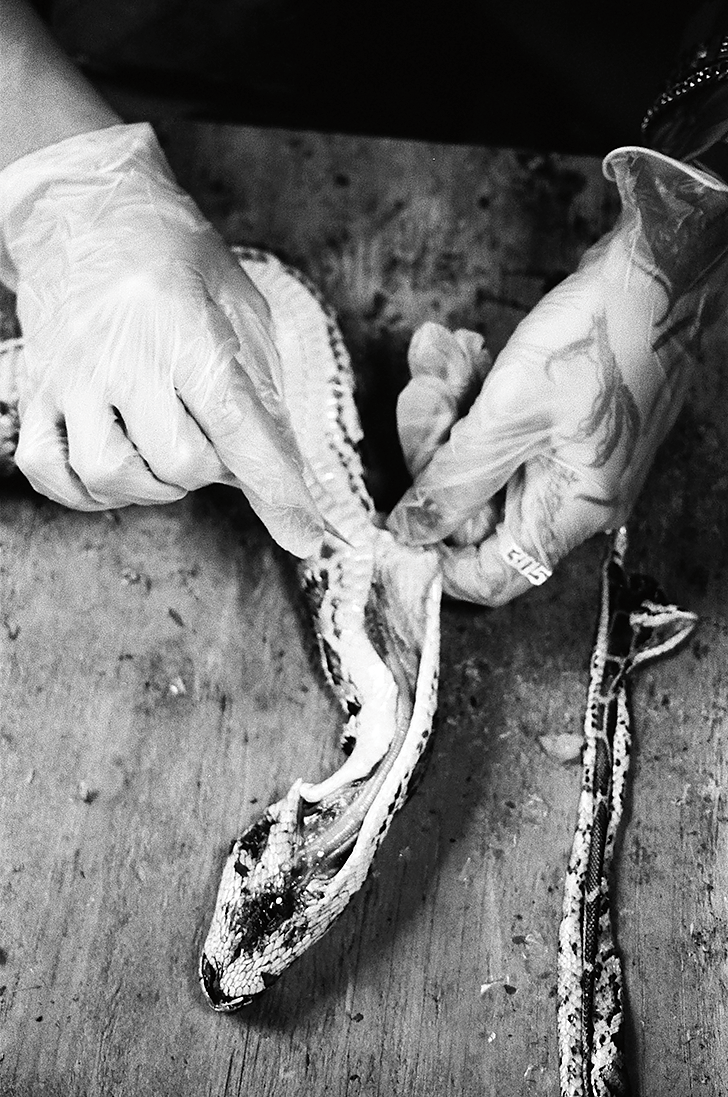
Barbeito removing the skin from a python using only a razor blade.
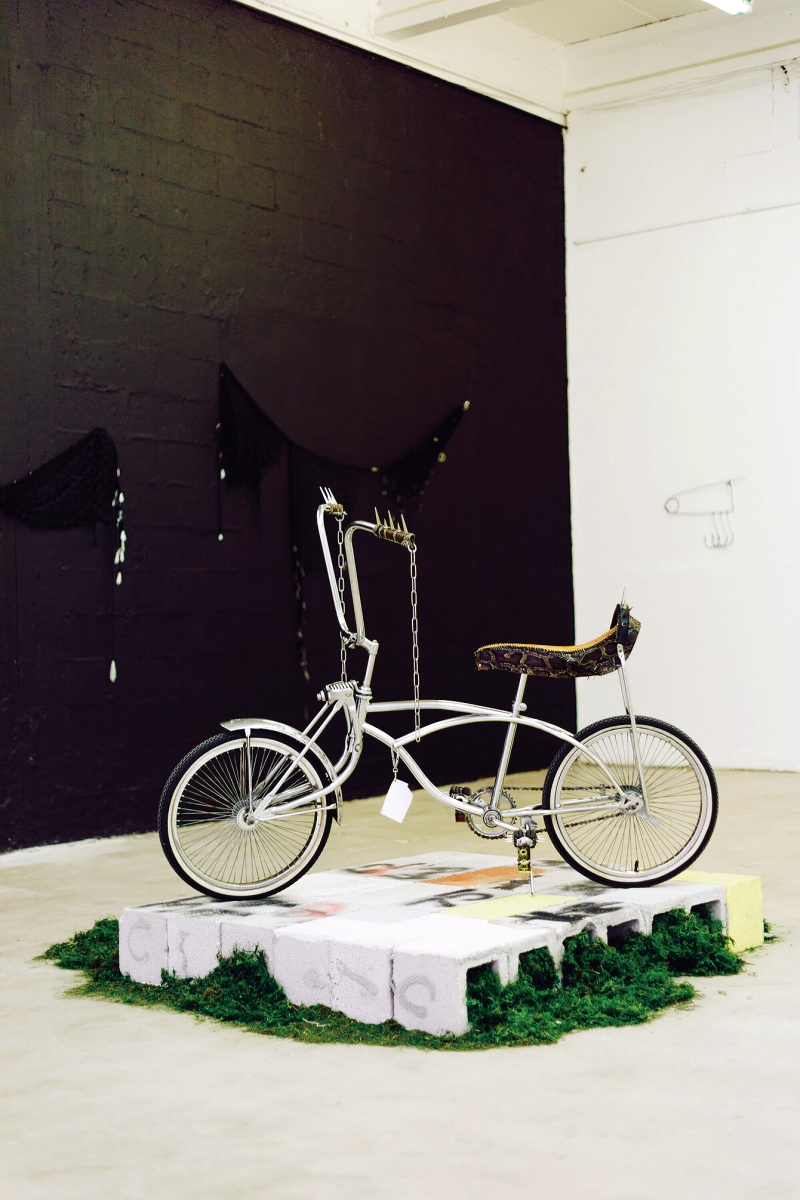
Low-rider bike decked out with vegetable-tanned leather, Burmese python skin, waxed cotton thread, and metal hardware.
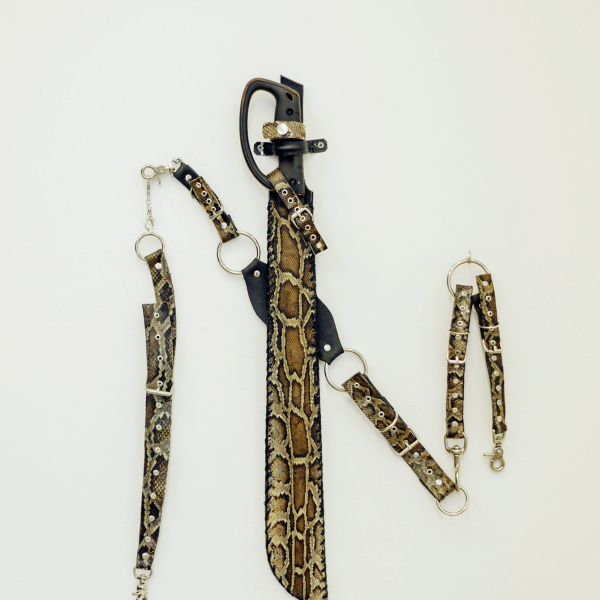
Barbeito’s machete sheath and cross-body harness with vegetable-tanned leather, Burmese python skin, waxed cotton thread, metal hardware.
At first glance, Barbeito’s work grapples with themes of violence and danger: machete sheaths, cross-body bags inspired by ammunition pouches, harnesses for pets and people glinting with long steel spikes—all covered in the scaly umber inkblots of python skin. Barbeito has said that her work “takes on the unforgiving, and often brutal, aspects of the natural environment.”
She also sees her style as an homage to the figure of the Cuban cowboy, her grandfather in particular. “He’s a huge influence in my life and upbringing,” she explains. “He was always very fascinated with the American lifestyle—of weapons, guns, cars—coming from Cuba, where those concepts are totally out of reach for its people and reserved for the government.”
On closer inspection, her pieces also convey a deep understanding of place; she strives to “immerse the viewer in a community defined by a swamp of survival.” A lawn chair with woven python webbing juxtaposes Florida’s domestic and wild natures. Another collection inspired by the creation of camouflage explores the environment through intimacy and visual mimicry.
Barbeito’s designs reflect the fierceness and fragility of making art in a time and place of ecological upheaval. Despite the slow and necessary eradication of the Burmese python from the Everglades, Barbeito’s work memorializes the misplaced giants that haunt the black water.
ellebarbeito.com | @ellebarbeito
Kimberly Coburn is an Atlanta-based writer and maker whose work explores the intersection of craft, the human spirit, and the natural world.
Photos by Alec Artidiello, Lauren Bouza, and Sasha Dokova


